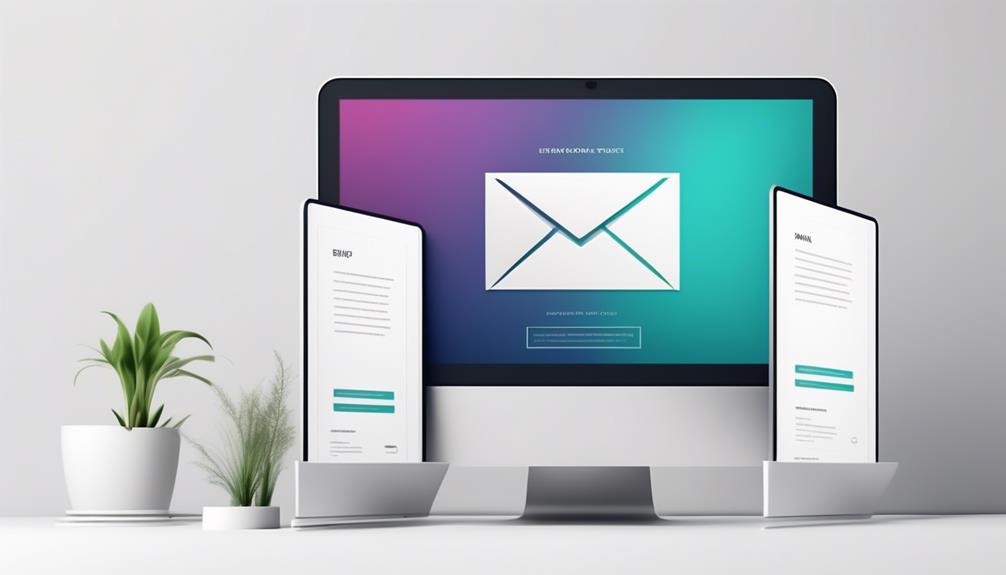In today’s fast-paced digital landscape, the question persists: is email marketing still relevant?
With the constant evolution of marketing channels and tactics, it's natural to wonder about the relevance of this tried-and-true method. However, before dismissing it as a relic of the past, we should consider the compelling evidence that suggests otherwise.
As we explore the statistics, trends, and benefits of email marketing, we'll unravel its enduring impact and potential for businesses in the modern era.
Key Takeaways
- Email marketing has evolved towards personalized and targeted campaigns, allowing for segmentation based on demographics, behavior, and interests.
- It is ranked among the top three most effective marketing channels by 79% of marketers, with higher open and click-through rates compared to social media and display advertising.
- Email marketing is cost-effective, with low costs per email and the ability to track and measure results for data-driven decision-making.
- Personalization in email marketing is crucial for delivering customized content, increasing brand recognition, customer satisfaction, and engagement, ultimately driving conversions.
The Evolution of Email Marketing
In our analysis of the evolution of email marketing, we've observed a significant shift towards more personalized and targeted campaigns, driven by advancements in segmentation and automation technologies. This shift has transformed email marketing from a generic broadcast medium to a highly targeted and personalized communication channel.
The ability to segment subscribers based on demographics, behavior, and interests has allowed marketers to craft tailored content that resonates with recipients, resulting in higher engagement and conversion rates.
Furthermore, the integration of automation technologies has enabled the delivery of timely and relevant messages, based on subscriber actions and behaviors. This hasn't only increased the efficiency of email marketing campaigns but has also enhanced the overall customer experience by delivering content that aligns with the recipient's journey.
As a result, email marketing has solidified its position as one of the most effective forms of digital marketing. The combination of targeted reach, cost-effectiveness, and high ROI has cemented its relevance and effectiveness in the ever-evolving landscape of digital marketing.
This evolution underscores the enduring power of email marketing as a strategic tool for businesses of all sizes.
Email Marketing Statistics and Trends

Analyzing the latest email marketing statistics and trends reveals compelling insights into the effectiveness and strategic relevance of this digital channel.
Email marketing continues to be a dominant force, with 79% of marketers ranking it among their top three most effective marketing channels. Its high open and click-through rates surpass those of social media and display advertising, making it an impactful method for engaging the target audience and driving conversions.
The ability to segment recipients based on demographics, behavior, and interests allows for highly targeted campaigns, enhancing engagement and conversion rates.
Moreover, its cost-effectiveness, with low costs per email and broad reach, ensures a high return on investment, making it accessible for businesses of all sizes.
Additionally, the ease of tracking and measuring results facilitates data-driven decision-making, enabling continual optimization of email marketing strategies.
These statistics and trends underscore the enduring power of email marketing as a pivotal component of successful marketing strategies.
Benefits of Email Marketing
We can clearly observe that email marketing enables businesses to reach a more targeted audience while remaining highly cost-effective compared to other marketing channels.
The benefits of email marketing extend beyond cost-effectiveness and targeted reach. It also allows businesses to stay in touch with current and potential clients, providing a direct line of communication that can be personalized and tailored to individual preferences.
Furthermore, email marketing has the potential to motivate readers to take action, whether it's making a purchase, signing up for an event, or sharing content with their network.
Additionally, the use of email marketing can streamline other marketing channels, serving as a central hub for content distribution and driving traffic to various digital platforms.
By leveraging the benefits of email marketing, businesses can cultivate stronger customer relationships, drive conversions, and maximize the impact of their marketing efforts.
Email marketing remains a crucial tool for businesses looking to engage with their audience in a targeted and cost-effective manner.
Effective Email Content Strategies
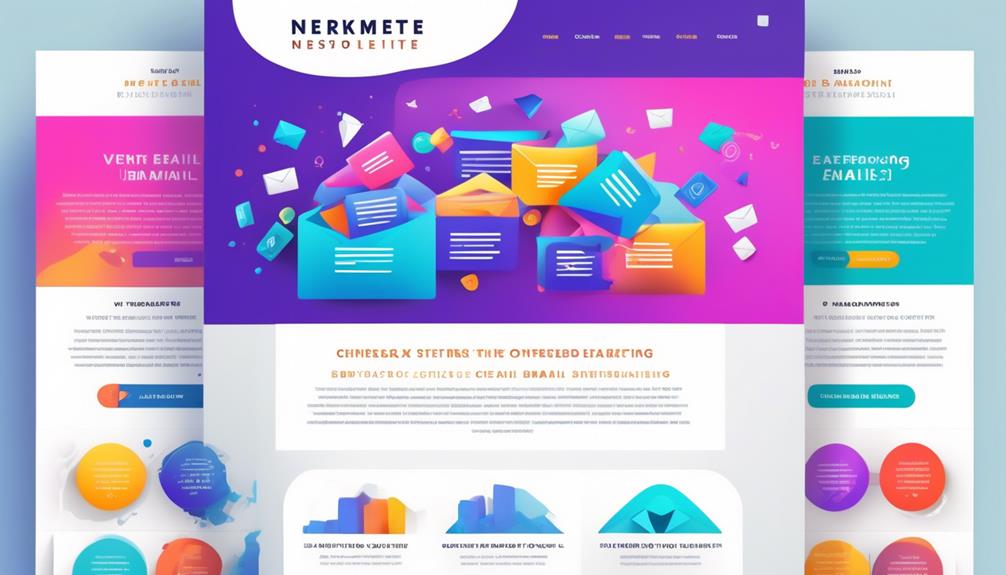
Utilizing personalized content is a key strategy for maximizing the effectiveness of email marketing campaigns. By tailoring messages to the recipient's interests and behavior, we can significantly enhance engagement and conversion rates. Compelling subject lines play a crucial role in capturing the recipient's attention and driving email opens.
Incorporating automation and drip campaigns enables consistent communication with subscribers, nurturing leads and fostering long-term relationships. Regular analysis of email campaign performance metrics is essential for identifying areas of improvement and optimizing future strategies to boost engagement and conversions.
Additionally, integrating clear calls-to-action (CTAs) prompts recipients to take specific actions, such as making a purchase or registering for an event, resulting in a higher likelihood of conversion. These effective email content strategies, when implemented thoughtfully and strategically, can elevate the impact of email marketing efforts, leading to increased ROI and sustained customer loyalty.
Personalization in Email Marketing
Personalization in email marketing is crucial for delivering customized content and segmenting the audience effectively.
By understanding the customer lifecycle and tailoring messages to individual preferences, we can create more engaging and relevant content for each stage.
Leveraging personalized email content can lead to increased brand recognition, customer satisfaction, and website traffic.
Customized Email Content
Enhancing email engagement through tailored content has been shown to significantly improve open and click-through rates, as it delivers relevant information to individual recipients based on their preferences, behavior, and demographics.
Utilizing personalized subject lines, product recommendations, and targeted offers can enhance engagement and conversion rates.
Customized email content allows for building stronger relationships with subscribers by showing that their individual preferences are valued.
Incorporating dynamic and interactive email content, such as personalized videos or interactive surveys, can further enhance the effectiveness of personalized email marketing.
Targeted Audience Segmentation
Targeted audience segmentation in email marketing allows for precise delivery of personalized content based on demographic, behavioral, and interest-based data insights. By segmenting subscribers into specific groups, we can tailor our email content to resonate with their unique preferences and behaviors. This data-driven approach enhances the effectiveness of email marketing, leading to higher engagement and conversion rates. Below is a table illustrating the potential segmentation criteria for targeted audience segmentation in email marketing.
| Demographic Segmentation | Behavioral Segmentation |
|---|---|
| Age | Purchase history |
| Gender | Email open rates |
| Location | Click-through rates |
| Income | Website interactions |
| Job title | Subscription preferences |
Automation and Email Marketing

Utilizing automation in email marketing allows for the precise targeting and personalized delivery of content to specific segments of our audience, based on their behavior, interests, and demographics. This strategic approach offers several advantages in our email marketing efforts:
- Efficiency: Automation streamlines the process of sending targeted emails, saving time and effort while ensuring consistent communication with our audience.
- Lead Nurturing: By setting up triggers and workflows, we can guide leads through the customer journey with timely and relevant emails based on specific actions or events, ultimately increasing engagement and conversions.
- Personalization: Automation enables us to engage subscribers with tailored content, such as welcome emails, abandoned cart reminders, and personalized product recommendations, enhancing the overall customer experience.
- Improved Results: Implementing automation in our email marketing strategy can lead to increased efficiency, higher engagement, and better outcomes by delivering the right message to the right people at the right time.
Incorporating email automation into our marketing approach allows us to leverage data-driven strategies to deliver targeted, personalized content, ultimately driving better results and enhancing the overall effectiveness of our email campaigns.
Maximizing Email Open Rates

We need to focus on crafting compelling subject lines that grab the reader's attention and entice them to open our emails.
Personalizing content and segmenting our audience can significantly improve engagement and open rates by delivering relevant information to the right recipients.
A/B testing is also crucial for optimizing our email campaigns and finding the most effective strategies for increasing open rates.
Catchy Subject Lines
Consistently crafting compelling subject lines is crucial for maximizing email open rates and engaging recipients from the outset.
When it comes to crafting catchy subject lines for email marketing, the following strategies can significantly impact open rates:
- Action-Oriented Language: Use powerful verbs and compelling language to prompt recipients to open the email and take action.
- Conciseness and Clarity: Keep subject lines clear, concise, and to the point to grab attention and ensure they aren't cut off on mobile devices.
- Personalization: Incorporate personalization, such as the recipient's name or specific details, to create a sense of individual connection and increase open rates.
- Strategic Emojis: Use emojis sparingly to add visual interest and convey emotion, ensuring they're relevant to the content and align with your brand voice.
Personalized Content
How can personalized content effectively maximize email open rates and drive subscriber engagement?
Personalized content is a crucial component in keeping email marketing still relevant. By tailoring messages to individual preferences and behaviors, open rates can significantly increase. Segmentation allows for targeted campaigns, improving the likelihood of subscriber engagement and conversions.
Consistently delivering personalized content fosters strong subscriber relationships, leading to higher engagement and open rates. Leveraging email marketing analytics provides valuable insights into subscriber behavior, enabling data-driven decision-making and campaign optimization.
Incorporating personalized elements, such as customized subject lines and individualized recommendations, has a substantial impact on email open rates and overall campaign effectiveness. Therefore, integrating personalized content into email marketing strategies is essential for maximizing open rates and driving subscriber engagement.
Email Marketing Analytics
What key insights do email marketing analytics provide into subscriber behavior and preferences?
Email marketing analytics offer valuable data that enables us to understand subscriber behavior and preferences in a more meaningful way. Here are the key insights provided by email marketing analytics:
- Measurable Results:
- Email marketing analytics allow us to track and measure the performance of our campaigns.
- This provides concrete data to inform our strategies.
- Segmentation Opportunities:
- By analyzing subscriber behavior and preferences, we can segment our audience based on demographics, behavior, and interests.
- This segmentation allows for the creation of highly targeted and personalized campaigns.
- Performance Metrics:
- Metrics such as open rates, click-through rates, and conversions can be measured and tracked.
- This provides actionable insights to optimize future campaigns.
- Campaign Optimization:
- Utilizing email marketing analytics enables us to continually optimize our campaigns based on data-driven insights.
- This improves performance over time.
Email Marketing Compliance and Privacy

In ensuring compliance with privacy regulations and anti-spam laws, obtaining explicit consent from recipients before sending marketing emails is a fundamental prerequisite. As internet users become increasingly concerned about data privacy, it's crucial for businesses engaged in email marketing to adhere to stringent compliance standards.
Regulations such as the GDPR and CAN-SPAM Act require marketers to obtain clear consent from individuals before sending promotional emails. Additionally, providing a simple and accessible method for recipients to opt-out of further communications is imperative to comply with email marketing regulations.
Furthermore, safeguarding the privacy of subscriber data and ensuring secure storage and handling of personal information is a non-negotiable aspect of email marketing compliance.
To maintain compliance and protect subscriber privacy, businesses must regularly review and update their email marketing practices to align with evolving privacy regulations and best practices. By staying abreast of these regulations and prioritizing privacy, businesses can establish trust with their audience and mitigate the risk of legal repercussions.
Ultimately, prioritizing compliance with privacy regulations and anti-spam laws isn't only a legal obligation but also a strategic imperative for the success of email marketing efforts.
Integrating Email With Other Channels
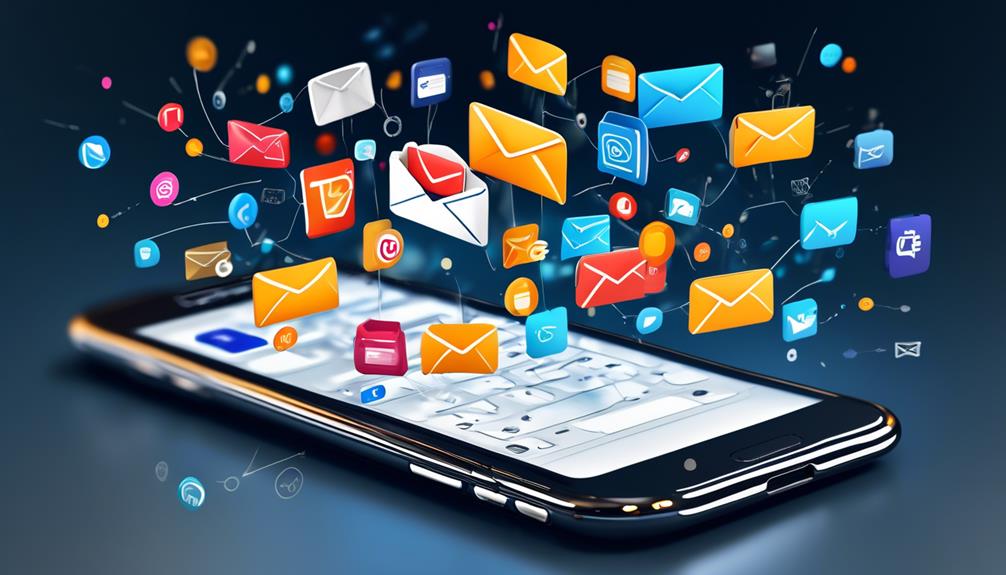
By integrating email with other channels such as social media, content marketing, and mobile marketing, we can amplify our message and reach a broader audience.
This ensures consistent brand messaging and personalized customer journeys, enhancing the overall effectiveness of our marketing efforts.
Pairing email with automation tools and CRM systems also streamlines our communication and enhances customer segmentation for more targeted campaigns.
Cross-Channel Promotion
Integrating email with other marketing channels through cross-channel promotion creates a cohesive and impactful strategy for businesses seeking to enhance brand visibility and reach a wider audience. This approach allows for a seamless customer experience by combining email with social media, content marketing, and more.
Leveraging multiple channels enables businesses to increase brand visibility and reach a wider audience, fostering customer loyalty and driving conversions. By integrating email with other channels, businesses can enhance engagement and create a unified marketing message that resonates across various touchpoints.
This strategic method not only amplifies the impact of email marketing but also ensures that the brand's message reaches the audience through diverse avenues, optimizing the overall marketing efforts.
- Seamless customer experience
- Increased brand visibility and wider audience reach
- Enhanced engagement and customer loyalty
- Unified marketing message across various touchpoints
Consistent Brand Messaging
Building on the foundation of cross-channel promotion, the integration of email with other marketing channels ensures a consistent brand message that resonates across diverse touchpoints and amplifies overall marketing efficacy. By aligning email campaigns with other channels such as social media, website, and offline marketing efforts, businesses can create a unified customer experience that strengthens brand visibility and recognition. Coordination of messaging and promotions across channels amplifies engagement and reinforces brand identity, enhancing customer journey touchpoints. This integration extends the reach and impact of brand messaging, ensuring that relationships take root. The table below illustrates the benefits of integrating email with other marketing channels to maintain consistent brand messaging.
| Benefits of Integration |
|---|
| Unified customer experience |
| Strengthened brand visibility |
| Amplified engagement |
| Reinforced brand identity |
| Extended reach and impact |
This data-driven approach emphasizes the strategic importance of consistent brand messaging in email marketing.
Personalized Customer Journeys
We leverage integrated email marketing to craft personalized customer journeys that enhance the overall customer experience and drive increased engagement and conversions.
Integrating email with other channels allows us to:
- Create cohesive and consistent messaging across various touchpoints.
- Deliver targeted and relevant content to customers based on their interactions with different platforms.
- Lead to increased engagement, conversions, and customer satisfaction.
- Gather valuable customer data and insights for more effective personalization and improved overall marketing strategies.
Email Marketing Best Practices
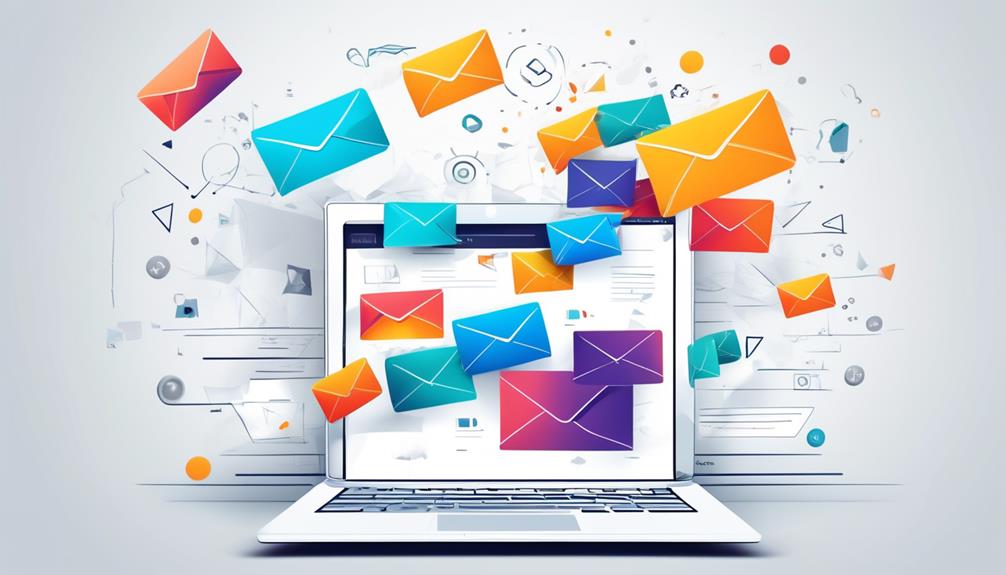
Using data-driven segmentation strategies, email marketing best practices can effectively target and engage specific audiences, maximizing the potential for conversions and ROI. By segmenting email lists based on demographics, behavior, and interests, marketers can tailor content to resonate with recipients, resulting in higher engagement and conversion rates.
Additionally, leveraging personalized customer journeys within email campaigns can further enhance the effectiveness of email marketing strategies. This involves mapping out the customer's interaction with the brand and delivering targeted content at each stage of the journey, nurturing leads and driving conversions.
Furthermore, best email marketing practices involve regular performance analysis and optimization. By tracking open rates, click-through rates, and conversions, marketers can identify what works and what doesn't, enabling them to refine their strategies for better results. It's essential to A/B test different elements such as subject lines, content, and calls to action to continuously improve campaign performance.
Overcoming Email Marketing Challenges

To enhance email marketing effectiveness, implementing targeted segmentation strategies based on demographics, behavior, and interests is crucial for overcoming challenges and improving open and click-through rates.
Here are four strategies for overcoming email marketing challenges:
- Personalized Content: Tailoring email content to resonate with specific audience segments based on their demographics, behavior, and interests can significantly increase engagement and conversion rates.
- Automation and Trigger Campaigns: Implementing automated email campaigns triggered by specific user actions or behaviors allows for timely and relevant communication, increasing the likelihood of conversion.
- A/B Testing: Conducting rigorous A/B testing on various elements such as subject lines, content, and calls to action helps in identifying the most effective strategies for engaging different segments of the audience.
- Data Analytics Utilization: Leveraging data analytics to track key performance metrics such as open rates, click-through rates, and conversions provides valuable insights for optimizing email marketing strategies and improving overall campaign effectiveness.
Case Studies: Successful Email Campaigns

Successful email campaigns can serve as valuable case studies, showcasing the implementation of targeted segmentation strategies to overcome challenges and achieve high engagement and conversion rates. By analyzing successful email campaigns, we can glean insights into the strategies and tactics that have yielded exceptional results. The table below presents key metrics from two renowned email campaigns, demonstrating their effectiveness in engaging recipients and driving conversions.
| Campaign Name | Open Rate | Click-Through Rate | Conversion Rate |
|---|---|---|---|
| Campaign A | 30% | 12% | 8% |
| Campaign B | 28% | 15% | 10% |
Campaign A targeted a niche audience segment based on specific interests, resulting in a high click-through rate and impressive conversion rate. On the other hand, Campaign B utilized demographic segmentation to tailor content, leading to a remarkable click-through rate and conversion rate. These case studies highlight the potency of targeted segmentation in driving the success of email marketing campaigns. By leveraging data-driven strategies and meticulous audience segmentation, businesses can emulate these successes and achieve outstanding results in their own email marketing endeavors.
The Future of Email Marketing
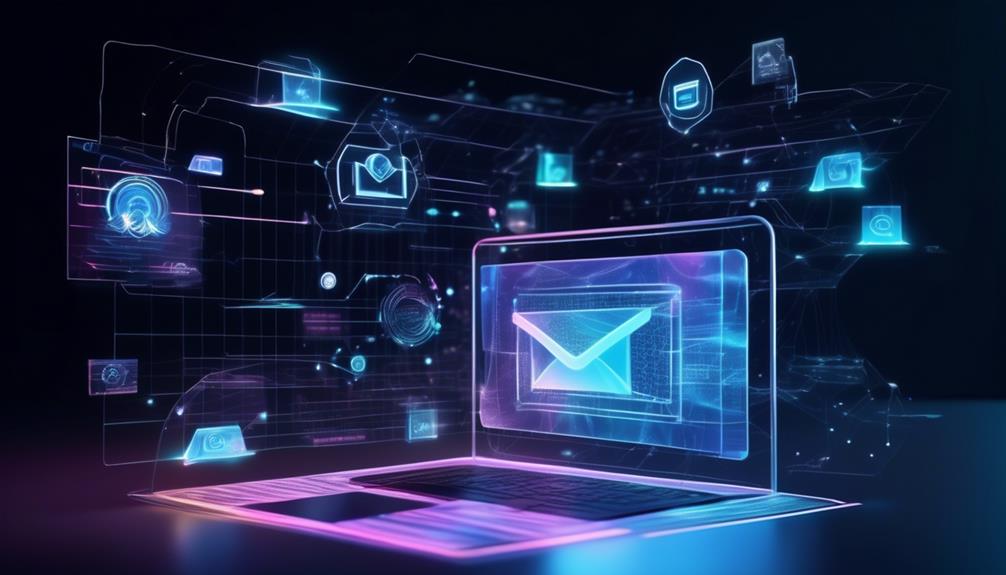
In forecasting the future of email marketing, we anticipate a continued evolution driven by technological advancements and data-driven strategies. The following factors will shape the future landscape of email marketing:
- Personalization and Automation: Advancements in AI and machine learning will enable even more sophisticated personalization and automation, allowing for hyper-targeted and timely communication with subscribers.
- Interactive Content: The future of email marketing will see an increase in interactive content, such as accordions, quizzes, and carousels, enhancing user engagement and providing valuable data for further personalization.
- Privacy and Compliance: With the evolving landscape of data privacy regulations, the future of email marketing will necessitate a heightened focus on compliance and transparent data practices to build and maintain trust with subscribers.
- Integration with Omnichannel Strategies: Email marketing will increasingly be integrated into broader omnichannel marketing strategies, providing a seamless and cohesive customer experience across multiple touchpoints.
As the digital marketing landscape continues to evolve, email marketing will remain a powerful and indispensable tool for engaging and nurturing customer relationships. The future of email marketing holds promise for those who adapt and leverage its evolving capabilities.
Conclusion: Email Marketing's Vital Role
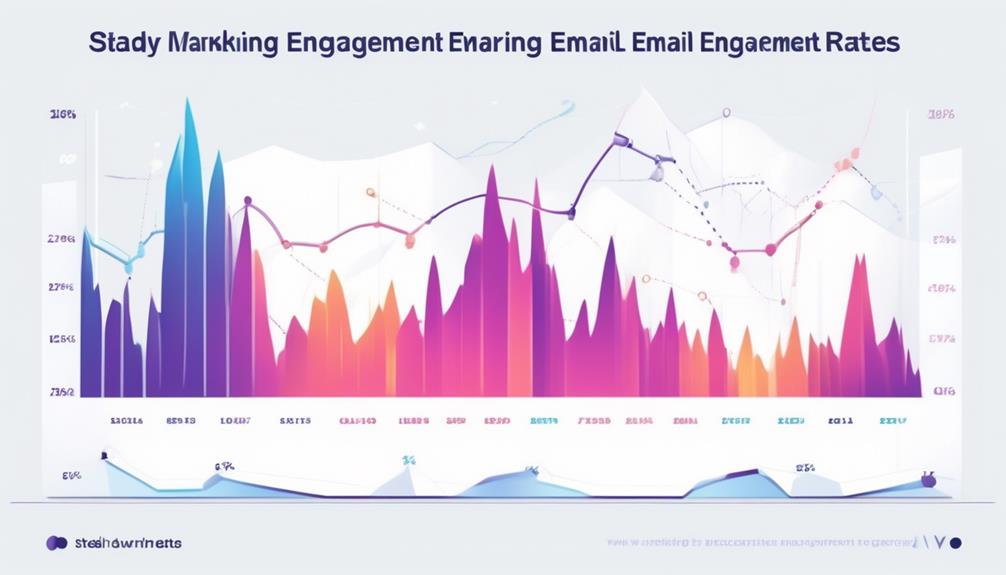
Email engagement rates and conversion tracking are critical components of email marketing that demonstrate its continued vitality and effectiveness.
By analyzing open rates, click-through rates, and conversion metrics, businesses can optimize their email campaigns for maximum impact.
These data-driven insights enable strategic decision-making and ensure that email marketing remains a valuable tool for reaching and converting customers.
Email Engagement Rates
With a focus on email engagement rates, our analysis underscores the vital role of email marketing in today's digital landscape.
- Email marketing boasts high open and click-through rates, making it an effective way to engage with your target audience.
- Its ability to allow for targeted reach through segmentation based on demographics, behavior, and interests enhances the chances of engagement and conversions.
- Email marketing is a cost-effective strategy, offering a large reach with a low cost per email and a high return on investment compared to other marketing channels.
- The measurable results and analytics provided by email marketing enable data-driven decision-making for optimizing campaigns and improving performance over time.
These factors highlight the significance of email marketing in driving engagement and achieving business objectives.
Conversion Tracking
Conversion tracking plays a crucial role in evaluating the effectiveness of email marketing campaigns, providing valuable insights for optimizing content and strategies to maximize ROI and drive business growth. By tracking and analyzing recipient actions, businesses gain a deeper understanding of customer behavior and can refine their email marketing approach for better results. The table below illustrates the key metrics and their significance in conversion tracking.
| Metric | Description | Importance |
|---|---|---|
| Conversion Rate | Percentage of email recipients who take a desired action | Indicates campaign effectiveness |
| Click-Through Rate | Percentage of recipients who click on a link | Measures engagement and content relevance |
| Revenue per Email | Total revenue generated from an email campaign | Demonstrates email's impact on sales |
Implementing robust conversion tracking is essential for businesses seeking to maximize the impact of their email marketing efforts.
What are the current trends and statistics showing the effectiveness of email marketing in 2023?
In 2023, the email marketing effectiveness 2023 remains strong, with statistics showing that personalized emails result in higher open and click-through rates. Trends indicate the increasing use of interactive emails and AI-driven personalization, leading to more engaging and targeted communication with customers.
Frequently Asked Questions
Is Email Marketing Still Effective Today?
Yes, email marketing remains effective today. It boasts high open and click-through rates, making it an impactful channel for engaging our audience and driving conversions.
Through targeted segmentation, we can create highly personalized campaigns, increasing the likelihood of engagement. Additionally, it's cost-effective with low costs per email and provides easy tracking for data-driven decision-making.
Is Email Marketing Still Relevant in 2023?
In 2023, email marketing remains a crucial component of our strategy. Its personalized content delivery and measurable results continue to drive engagement and conversions.
With high open and click-through rates, it effectively reaches our target audiences. The ability to segment and target specific demographics, behaviors, and interests makes it a powerful tool for tailored communication.
Moreover, its cost-effectiveness and high return on investment solidify its relevance in 2023.
Is Email Marketing Outdated?
Yes, email marketing isn't outdated. It remains a vital tool for reaching and engaging our target audience.
With its high open and click-through rates, cost-effectiveness, and segmentation capabilities, it continues to drive conversions and provide a high ROI.
Email marketing's trackability and measurement also offer valuable insights into subscriber behavior and preferences, allowing for data-driven decision-making.
Therefore, it remains a relevant and effective marketing strategy in 2023.
Is Email Marketing Still Profitable?
Yes, email marketing is still profitable. We've observed high engagement and conversion rates compared to other channels.
Our targeted segmentation strategy has increased ROI, and the measurable results drive continuous optimization.
With its massive reach and evolving effectiveness, email marketing remains a powerful tool for businesses.
Our data-driven approach proves its profitability, making it a vital component of our marketing strategy.
– Can Email Marketing Still be Effective for Business Growth?
Yes, email marketing uses are still effective for business growth. With the right strategy, businesses can achieve great results through personalized and targeted email campaigns. By engaging with their audience through relevant content and promotions, businesses can build brand awareness and drive sales through their email marketing efforts.
Conclusion
In conclusion, email marketing continues to prove its effectiveness in reaching and engaging a targeted audience. Its high open and click-through rates, cost-effectiveness, and measurable results make it a vital tool in digital marketing.
As businesses adapt to changing trends and utilize personalized content strategies, email marketing will remain a powerful way to connect with customers. The future of email marketing looks promising, with the potential for even greater success and innovation.





